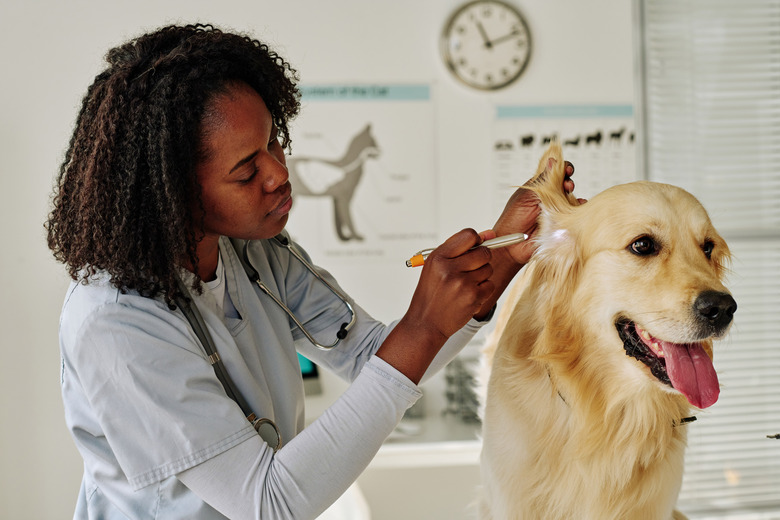Home Remedies For Ear Mites In Dogs
Ear mites are a type of parasite that can live in a dog or cat's ears. They can cause a significant amount of itching and even result in a secondary ear infection that consists of bacteria and/or yeast. Home remedies are not scientifically proven to kill ear mites nor will they address any secondary issues that can arise, such as an ear infection or an ear hematoma. If your pet has itchy ears, a swollen ear, a painful ear, or a lot of ear wax or debris in their ears, they need to see the veterinarian right away.
What are ear mites in dogs?
What are ear mites in dogs?
The ear mite of dogs (and cats) is a parasite called Otodectes cynotis. An infestation with this parasite is actually more common in feral cats than it is in dogs. If you feed feral cats in your yard, your dog can potentially pick up ear mites from them (if the cats have them.) A dog can also pick up ear mites from an infected dog.
The mite is about 0.3 to 0.4 millimeters long, which means they are barely visible to the naked eye. Your veterinarian will do an exam on your dog, which includes looking in their ear canal with an otoscope. During this part of the exam, they will take a swab and sample the debris or discharge in your pet's ear and look at it under a microscope.
The life cycle of Otodectes cynotis is 21 to 28 days and takes place entirely in the ear canal. This parasite tends to stay in the ear, but occasionally, they may wander out to other areas of a dog's skin. If your pet is itchy on other parts of their body, let your veterinarian know.
Signs your dog might have ear mites
Signs your dog might have ear mites
Symptoms of ear mites can vary from one animal to the next. If your dog has an ear mite infection, they will likely have one or more of the following:
- Head shaking
- Scratching at the ears
- Dry, waxy sheets of debris in the ears
- Coffee-groundlike debris in the ears
- Puslike discharge in the ears (due to a secondary ear infection)
- Bleeding or scabs on or around the flap of the ear
- Scratching to the point of causing an ear hematoma. This is when blood vessels burst within the flap of your dog's ear. It often requires surgery.
Can I treat dog ear mites at home?
Can I treat dog ear mites at home?
No, you should not only treat your dog's ear mites at home. If your pet's ears are not painful or swollen or do not have an odor, you can try a home remedy to remove debris from your pet's ears while you're waiting for their veterinary appointment. Consult your veterinarian before using any home remedy in your pet's ears.
If your pet's ears are painful, bleeding, swollen, or smelly, definitely do not use any home remedy in their ears, as you can potentially cause more damage. Don't expect any home remedies to be a cure or a substitute for professional veterinary care.
Home remedies for ear mites in dogs
Home remedies for ear mites in dogs
Consult your veterinarian before using any of these home remedies in your pet's ears. In the case of ear mites, home remedies are not meant to cure your pet. If your pet's ears are painful, bleeding, swollen, or smelly, do not put any home remedy in your pet's ear canal because you can create more inflammation or damage the eardrum. Things like hydrogen peroxide, essential oils, or tea tree oil should never be placed in your dog's ear canal. Don't try to soak off or pick off any scabs that are in or around your pet's ears.
Just because you can find a home remedy on the internet does not mean it is safe or appropriate for your pet.These topical products are merely intended to soften and remove debris from your pet's ear. If your pet acts pained during or after use of any home remedy, discontinue using it and call your veterinarian.
The more time you spend doing a home treatment for ear mites, the longer the inflammation of the ear mites will continue. This can result in more discomfort or pain for your pet, and it increases the chance of a secondary infection or a hematoma developing. A pet can have dozens to hundreds of mites crawling around in their ear canal. It's not worth keeping them uncomfortable or even in pain for weeks while trying a home remedy.
Antiseptic tea rinse
This solution is made with loose green tea leaves or a bag of green tea. Don't try to soak off or pick off any scabs that are in or around your pet's ears.
- Steep green tea for three to five minutes.
- Allow it to cool to room temperature.
- Soak cotton balls with the tea.
- Use them to wipe out your dog's ears.
- Wipe up any excess liquid with a couple of dry cotton balls. Q-tips can be used in the grooves of the ear flap but don't put them down into the canal.
- Use it once every 24 to 48 hours for no more than a week. Your pet should see a veterinarian by then.
Apple cider vinegar
Since this is acidic, it should not be used on dogs who have any redness, sores, swelling, or scabs in, on, or around their ears.
- Mix one part apple cider vinegar with one part water.
- Soak two to three cotton balls with the mixture.
- Use them to wipe out your dog's ears.
- Use a dry cotton ball or two to wipe up any excess liquid from your dog's ear. If your pet is a toy or small breed, you may need to pull a cotton ball apart into two pieces before using it. Q-tips can be used in the grooves of the ear flap but don't put them down into the canal.
- If your dog whines or cries, do not continue to use this.
- Use this once every 24 to 48 hours for no more than a week. Your pet should see a veterinarian by then.
Baking soda
Since pets with ear mites tend to have irritated skin in and around their ears, baking soda is not appropriate to put in your pet's ears. It can be drying and cause further irritation.
Coconut oil or olive oil
The directions are the same for both of these but just pick one or the other. Don't try to soak off or pick off any scabs that your pet has in or around their ears.
- If you're using coconut oil and it is solid, warm it up either on the stove or briefly in the microwave.
- Once the oil has cooled off (if you're using coconut oil) and is just above room temperature, pull some up into a dropper.
- Using a dropper, put five drops in your pet's ear.
- Gently massage the base of your pet's ear.
- Wipe out your dog's ears with one or two cotton balls. If needed, you can apply oil to a cotton ball to pick up more debris. If your pet is a toy or small breed, you may need to pull a cotton ball apart into two pieces before using it.
- You can use Q-tips in the grooves of the ear flap but don't put them down into the canal.
- Use this twice a day for no more than a week. Your pet should see a veterinarian by then.
Treating ear mites in dogs with mineral oil
Treating ear mites in dogs with mineral oil
Mineral oil does not kill ear mites on contact. It just serves as a gentle ear cleaner. Your pet will need medication to kill the mites, so be sure to make an appointment with your veterinarian as soon as possible. If your pet's ears are painful, bleeding, swollen, or smelly, do not put mineral oil or any other home remedy in their ear. Consult your veterinarian before using mineral oil in your pet's ears.
Mineral oil is commonly found in baby oil, but baby oil tends to be scented. If your veterinarian says it is ok to clean your dog's ears with mineral oil, do not use anything that has fragrance or other ingredients added to it. Don't try to soak off or pick off any scabs that your pet has in or around their ears. Your veterinarian will give you instructions on how to clean your dog's ears with mineral oil if they feel it is ok to do.
Conventional ear mite treatment in dogs
Conventional ear mite treatment in dogs
If your veterinarian diagnoses your pet with ear mites, they'll do an ear cleaning at the time of the exam. They may also send home an ear cleaner. Depending on your pet's age, your veterinarian may dispense a medication such as Revolution, Simparica, Milbemite, Tresaderm ear drops, or Bravecto.
In addition to checking your pet for ear mites, your veterinarian will also look at ear swabs to see if there is any bacterial and/or yeast overgrowth. Bacteria and yeast both normally live in a dog's ears and on their skin, but they can overgrow when inflammation is occurring. A dog ear infection should not be treated at home with over-the-counter products. Prescription medications are necessary.
The bottom line
The bottom line
Ear mite infestations are caused by a parasite that lives in the outer ear canal of infected dogs. They can cause secondary ear problems, such as a hematoma, a bacterial infection, or a yeast infection. Some signs of ear mites are intensely itchy ears and debris in the ears that may look like coffee grounds or dry waxy sheets. In order to effectively treat ear mites and any secondary issues, your dog needs to see a veterinarian right away. Natural remedies, such as mineral oil, can help with ear cleaning by softening the buildup of debris in your dog's ear canal, but they are not meant to be a cure. Dog owners who notice their pet has itchy ears or ears filled with dark debris should take their pet to a veterinarian for effective treatment.



